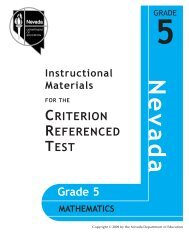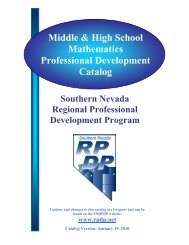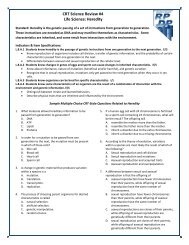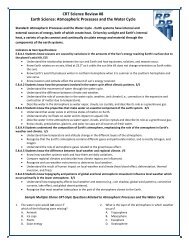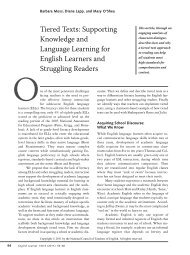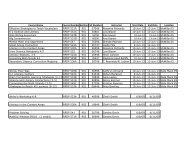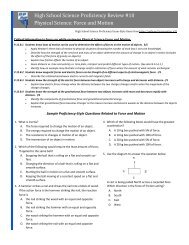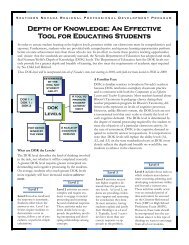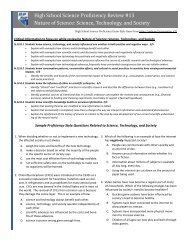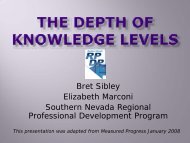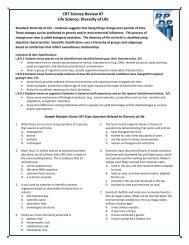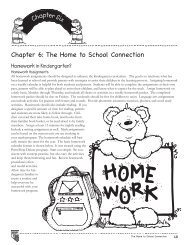Download - RPDP
Download - RPDP
Download - RPDP
Create successful ePaper yourself
Turn your PDF publications into a flip-book with our unique Google optimized e-Paper software.
this format, concept words are given to the<br />
students with the following instructions.<br />
1. Link the concept words in a reasonable and<br />
sensible matter.<br />
2. Put a circle around the concept word<br />
3. Provide a one or two sentence description<br />
that shows how the two concepts are<br />
linked.<br />
4. The linked sentences should contain<br />
the two concept words that are being<br />
connected.<br />
5. The map should be scored on the quality of<br />
the link description<br />
a. Detailed and correct link description<br />
that is evident of deep understanding (2<br />
points)<br />
b. Shallow (superficial) and correct link<br />
description that is evident of partial<br />
understanding (1 point)<br />
c. Incorrect description (0 point)<br />
These instructions are very simple, but<br />
encourage students to generate as many<br />
descriptive and accurate links as possible. Note,<br />
the focus here is on the connection, not the<br />
concept word, which is given to the students.<br />
There is no upper limit to the number of points<br />
students can get on this activity, which motivates<br />
students to create more links. These maps can<br />
be graded on a criterion scale that is based on<br />
the number of content words. For example, if<br />
20 concept words are included, an excellent<br />
concept map would include at least 20 detailed<br />
and correct links (40 points).<br />
In a preview or review scenario, concept<br />
mapping may be facilitated by students working<br />
in groups of two or three. This encourages<br />
students to think aloud as they discuss linkages<br />
between concepts. Also, the teacher acts as the<br />
role of the coach by circulating around the room,<br />
asking students to provided reasoning for their<br />
links, and providing cues to help them achieve<br />
a deeper level of processing. Students can<br />
prepare their maps on large poster size pieces<br />
of paper, which allows the entire group to be<br />
engaged in the activity.<br />
Ultimately, as concept mapping is used<br />
frequently throughout the school year, students<br />
develop the organization skills, which help<br />
the students’ metacognitive knowledge. The<br />
concept map also serves as a way to monitor<br />
this metacognitive organizational process. In this<br />
way, students are self-assessing their overall<br />
understanding of science.<br />
Interactive Science Notebooks<br />
Metacognitive knowledge and monitoring<br />
can also be developed through interactive<br />
note taking, particularly by helping students<br />
with “real-time” organization of information<br />
presented during class time. The interactive<br />
science notebook organizes science knowledge<br />
in three parts labeled, the (a) IN question, (b)<br />
THROUGH section, and (c) OUT question.<br />
More details about these sections and how to<br />
implement interactive science notebooks are<br />
found in Volume 2, Issue 2 of <strong>RPDP</strong>’s Science<br />
Dissected Newsletter. This particular newsletter<br />
was written by <strong>RPDP</strong> Regional Science Trainer,<br />
Bret Sibley, and is found at http://rpdp.net/adm/<br />
uploads.news/sciencedis/57v2i2SDInteractiveSc<br />
ienceNotebooks.pdf.<br />
Building Success on Success<br />
Using concept mapping and interactive science<br />
notebooks require initial time for training at<br />
the beginning of the school year. But such<br />
investments in time pay huge dividends later<br />
when students begin to reason scientifically by<br />
actively organizing their knowledge in a way that<br />
help them solve problems in a more efficient<br />
and accurate manner. Taking this initial time to<br />
build success on success will motivate students<br />
to engage in metacognitive processes that will<br />
deepen their understanding of science content<br />
and increase their achievement in science,<br />
especially if concept mapping and interactive<br />
notebooks are embedded within the concepts<br />
being taught.<br />
Reference<br />
Anzai, Y. (1991). Learning and use of<br />
representations for physics expertise. In K. A.<br />
Anders & J. Smith (Eds.), Toward a general<br />
theory of expertise (pp. 64-92). New York:<br />
Cambridge University Press.



